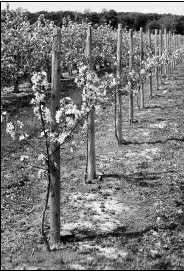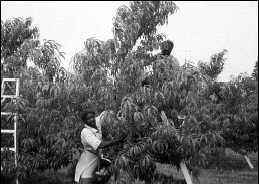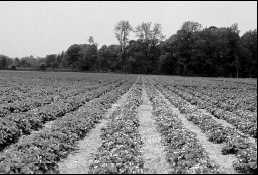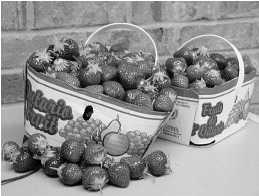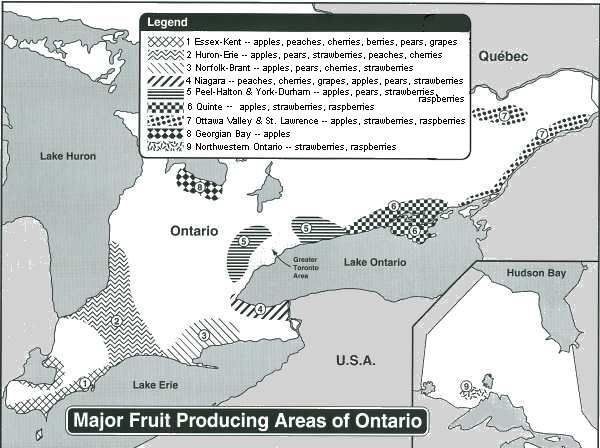What you should know about fruit production in Ontario
Learn the basics of growing apples, grapes and tender fruit in Ontario.
ISSN 1198-712X, Published June 2004
Introduction
The unique blend of climate, geography and soils found in certain areas of Ontario allow producers to grow a wide variety of top quality fruits. The shaded area on the map represents the regions with climate and soils most suited to the production of fruit. In addition to apples and peaches, Ontario fruit growers grow grapes, pears, nectarines, apricots, plums, prunes, cherries, raspberries, strawberries and blueberries. Many newer and unusual crops like northern kiwi and Saskatoons can be found in limited quantities.
Ontario's commercial fruit producers grow more than 450,900 tonnes of fruit annually on 25,294 ha of land. The total farm gate value is over $225 million.
This fact sheet focuses on the fruits most valuable economically to Ontario growers. These include tree fruit: apples, pears, peaches, plums, cherries and nectarines; small fruit; strawberries, raspberries, currants and gooseberries; and grapes.
Apple growing in Ontario
Climate, geography and soils
The major apple-producing areas in Ontario are spread along the shores of Lake Ontario, Lake Erie, Lake Huron and Georgian Bay. These large, deep bodies of water are the main reason that apples are one of Ontario's biggest and most diverse fruit crops. The water temperature of the lakes changes slowly and causes the air temperatures of the adjacent shore to change slowly as well. As a result, late spring frosts and early fall frosts are buffered and the growing season is extended.
The Niagara Escarpment plays a role in creating good apple-growing conditions in many areas. The towering escarpment provides a protective boundary, confining the moderate air temperatures influenced by the lakes in a small, productive area.
In addition, there are a wide variety of fertile soils in these areas, ranging from sandy loams to clays, making them well suited to growing apples.
Economics
The growing of fruit crops in Ontario is both labour and capital intensive. Investments can exceed $25,000/ha or $10,000/acre to establish orchard plantings. Return on investment can be unpredictable and highly dependent on cultivar and market position of an individual producer. Annual cost of production is typically in the range of $8,500-$10,000/ha or $3,500-$4,000/acre. Crop insurance programs and other safety net programs are available to producers of major fruit crops in Ontario. These programs are intended to help manage risk. With orchard crops, a grower can expect 60% overhead with or without a crop on an annual basis.
Production, varieties and yields
In recent years, the Ontario apple crop has averaged about 0.25 million metric tonnes or 13.7 million bushels. One million metric tonnes is equivalent to 53 million bushels. Included are the following varieties with approximate production percentages:
- Cortland - 0.5%
- Gala - 1%
- Jonagold - 1%
- Golden Delicious - 1%
- Spartan - 1.8%
- Mutsu - 2%
- Idared - 7%
- Northern Spy - 10%
- Red Delicious - 12%
- Empire - 19%
- McIntosh - 27%
- Others - early and late varieties - 17.7%
The growers
There are approximately 700 apple growers in Ontario. While some of them manage orchards larger than 40 ha or 100 acres, the average size is about 8 ha (20 acres). Using modern technology, Ontario growers have become increasingly efficient. They are gradually converting older orchards, which have large, standard-sized trees to higher density orchards with "size-controlled" or dwarf trees. This change to a higher number of trees per hectare increases orchard efficiency. The trend in Ontario is to pedestrian orchards where practices can be carried out with minimum use of ladders.
Recent estimates of acreage in Ontario have the number of growers with 4 ha (>10 acres) at 400. This group of growers manages approximately 6,500 ha or 16,000 acres of apples.
Growers also use improved storage techniques that allow consumers to enjoy quality Ontario apples year round.
Marketing
About half of Ontario's apples are marketed as fresh apples. The other half is used for processing. Of the fresh-market portion, three-quarters are marketed through apple packers who distribute the product to grocery stores. Pick-your-own operations, farmers' markets and roadside stands mostly use their own production.
Ninety percent of the processing apples are used to make juice. Other uses include applesauce, slices and pie fillings. McIntosh apples are most often used for juice and Northern Spys for pie filling.
Most packers distribute apples under the "Orchard Crisp" brand name. All "Orchard Crisp" apples are grown in Ontario and must meet strict standards for quality control.
The Ontario apple crop has a value to apple growers of about $85 million per year, also expressed as the farm gate value. In addition, Ontario exports approximately 10% of its apples. Importing countries include the United States, which receives the largest percentage of our exports at 65%, and the United Kingdom, which receives about 30% of total exports.
Additional statistical information on the Ontario Apple Industry can be found on the OMAFRA website.
Industry organization and structure
A new marketing board for apples was created in May 2004. The Ontario Apple Growers (OAG) will annually negotiate the price for juice apples and provide industry leadership in the areas of government relations, grower information, research and development and promotion. The OAG shares services and offices with the Grape and Tender Fruit (Ontario) Ltd. Offices in Vineland Station. All commercial operations of 4 ha (>10 acres) will be included. A licence fee of $20.00 per acre is payable to the board annually.
Grapes and tender fruit production in Ontario
Only Ontario and British Columbia are capable of large-scale commercial production of tender fruit and wine grapes. Tender fruit production includes peaches and nectarines, pears, sweet and sour cherries, plums and apricots. Grapes include native labrusca types for processed juice and fresh market, French hybrid and Vitis vinifera types for wine.
There are two major tender fruit and grape areas in Ontario. The Niagara Peninsula below the Niagara Escarpment is Ontario's largest and most important fruit-growing area. The main production area extends approximately 45 km east to west along a narrow strip on the south shore of Lake Ontario from Niagara-on-the-Lake. A small area in Pelham, located in the middle of the peninsula, is also suited for growing tender fruit such as peaches, cherries, pears and plums.
Isotherms and suitable topography allow for a variety of tender fruit plantings along the Lake Huron shoreline from Goderich down into Lambton County. An isotherm is a line on a map connecting points on the earth's surface having the same average temperature or the same temperature at a given time.
The second area is Essex and Kent counties, located in the southern-most part of the province, have the longest growing season in Ontario.
Climate, geography and soils
The Niagara Peninsula below the Niagara escarpment has a moderate climate due to its two natural boundaries - Lake Ontario and the Niagara Escarpment. Lake Ontario is a major influence on the climate of the fruit production area because it absorbs vast amounts of heat energy during the summer, releasing it slowly over the winter as long as there is open water. A downhill breeze develops from the top of the Niagara Escarpment creating an airflow pattern that draws warmer air from higher inversion layers. As a result, the lake moderates temperature fluctuations by warming the offshore breezes in winter and cooling the onshore breezes in summer. This moderating influence is important as winter temperatures in the region rarely go below -18°C or greater than 30°C in the summer.
This effect delays the development of the fruit buds in spring, reducing the chance of damage caused by spring frost. The first fall frost is also delayed allowing for a longer growing season and greater heat units late into the season.
The soil types in the Niagara Peninsula below the escarpment also help fruit trees thrive. Soils vary from well-drained sands and gravel type soils to poorly drained silt and clay loam soils. Most of the sand and gravel soils are located near the shore of Lake Ontario, along the Niagara River and in the Pelham area and are suitable for peaches, nectarines, cherries, apricots and berry crops. The silt and clay loam soils are more suited to grapes, pears, plums and apples.
In Essex and Kent counties, the proximity to Lake Erie creates moderate winters. Lake Erie is shallow relative to the other Great Lakes and some years, areas of the lake freeze. When the lake freezes, the moderating effect is lost. Approximately once every 10 years, a serious drop in winter temperatures occurs. This can result in significant injury to tender fruit and grapes.
Production
Ontario tender fruit and grapes return approximately $100 million to the area each year. Approximately $60 million of that comes from fresh and processing grapes, $22 million from fresh and processing peaches, and $18 million from the other tender fruit trees. Ontario has more than 900 tender fruit producers, many of them operating farms of less than 20 ha. However, approximately 20% of the growers produce 80% of the total value of production.
The Niagara Peninsula produces more than 94% of Ontario's grapes, 90% of its peaches, nectarines and apricots, 80% of its plums, 75% of its sweet cherries, 72% of its pears and 60% of its sour cherries. There has been a large increase in plantings of higher value grape cultivars in recent years. This is a response to the demand for higher quality wine. Grapes have replaced some tender fruit and most of the apple acreage in the Niagara Region.
Growers in Essex-Kent produce all types of tender fruits and grapes. Pelee Island, the most southern portion of Canada, has one of the largest concentrations of Vitis vinifera grapes.
Haldimand-Norfolk counties are a new area for sour cherries and represent 25% of the production in the province. Prince Edward County along the Bay of Quinte is an emerging area for grape production but still needs to be tested for cold winter temperatures and a shorter growing season.
Marketing structure and grower organization
The Ontario Tender Fruit Producers' Marketing Board is the grower organization that is involved with marketing, promotion, price setting, supporting research and other issues that continue to emerge.
The Grape Growers of Ontario is involved with promotion, price setting, marketing, supporting research and other issues that continue to emerge.
Wine industry in Ontario
Ontario produces over 85% of Canada's domestic wines on 7,000 ha of vineyard in the Niagara Peninsula, southwestern Ontario and Prince Edward County. Vitis vinifera types account for approximately 55% of Ontario's production and the trend is increasing each year. French hybrids represent 25% and labrusca 20%.
Ontario produces many wines whose quality is recognized worldwide.
- Ontario wines represent 40% market-share in Ontario.
- There are more than 50 wineries in Ontario, with more opening each year.
- Grape growing provides 12,000 full-time and seasonal jobs.
- Ontario wineries have expanded their export markets, exporting to countries such as the United Kingdom, Japan and the United States.
- Fine quality fruit wines made from fruit other than grapes can be found at markets across Ontario.
Berry production in Ontario
Berries are an important fruit crop that can be successfully grown in many parts of Ontario. Annual farm gate value of berry crops in Ontario is $20 million. A steady consumer demand can make berry production profitable. Like many high value crops, berry production is labour intensive and carries a high degree of risk. Marketing this perishable crop is demanding and challenging. Attention to detail is required at all stages of berry production, from planning, planting and crop management, to managing pests, harvesting, cooling or field heat removal and marketing.
Strawberries, raspberries and blueberries are grown across the province, mostly around major urban centres. Labour supply and an adequate customer base are two essential ingredients for success to most berry farms. Berries are largely hand harvested and extremely perishable. Berry crops are generally grown on the best agricultural soils, requiring excellent drainage and high organic matter for optimum production. Blueberry crop production is further limited to soils with low pH, 4.5-5 eing ideal.
Berry nursery stock is propagated vegetatively, from runners, cuttings or root suckers. The potential to spread disease into new planting material is high for these crops. It is important to start new plantings with plant material grown under a certified or accredited plant propagation program. There are three plant growers in Ontario who provide plants grown according to an accredited program.
Strawberries: Approximately 1,600 ha (4,000 acres) of strawberries are harvested each year. Most strawberry growers have small acreages of strawberries in addition to other crops. Less than 20% of strawberry farmers have 4 ha (>10 acres) in production, however these growers produce over 70% of the Ontario crop.
Most strawberries are grown in a matted row system, grown vegetatively in the first year, and harvested for 2-4 years after planting. Other systems include plasticulture production of both day-neutral and June-bearing varieties. In this high density planting system, plants are grown on raised beds with trickle irrigation and plastic mulch. Strawberry plants are one of the least hardy herbaceous perennials. In most regions of Ontario they are protected during the winter with straw mulch.
Strawberries are mostly harvested by pick-your-own customers, or hand harvested for sale at the farm-gate, local, or farmers markets. Larger growers supply the major retail markets. A small percentage of the total crop is processed.
Brambles: Brambles include summer bearing and fall bearing red raspberries, black raspberries, blackberries and hybrids of these, such as tayberry, loganberry and boysenberry. Red raspberries are by far the major type of bramble. Approximately 405 ha (1,000 acres) of raspberries are grown in Ontario, for fresh sales, at the farm gate, or local farmers markets. High production costs, problems getting pickers and the extremely perishable nature of raspberries after harvest limit the supply of fresh raspberries in Ontario.
The varieties grown depend on the local climate and potential for winter injury. Winter hardy varieties of summer red raspberries (i.e. Boyne) are grown in many parts of Ontario. However, blackberries, and the larger-fruited, high quality red raspberries required for long distance shipping are winter hardy in only the warmest parts of the southwestern Ontario and Niagara.
Fall bearing, or primocane fruiting raspberries are also grown. Production of this crop is limited by fall frosts. As new, earlier varieties of fall bearing raspberries are developed, production of this type for raspberry is increasing.
Blueberries: There are approximately 200 ha (500 acres) of highbush blueberries grown mainly in southern Ontario on lighter soils, where the climate is moderated by the Great Lakes. Lowbush blueberries are also cultivated on a small scale. Most lowbush blueberries however, are harvested from wild or managed wild stands. These wild blueberries grow naturally in northern or eastern Ontario, where soils, originating from the Canadian Shield, are inherently more acidic than the limestone based soils in southern Ontario.
Most blueberries are harvested as pick-your-own, or hand harvested for local markets. A small percentage of the crop is machine-harvested.
Other small fruit: There are less than 40 ha (100 acres) of currants and gooseberries grown in Ontario. These are sold at local farm markets, or processed for specialty wines and jams. In the absence of a processing industry, marketing these fruits on a large scale is unlikely. White pine blister rust is a potential problem for black currants, particularly in forested regions of Ontario. New disease resistant varieties of black currant have rekindled interest in this crop. Cranberry production is concentrated near Bala, Ontario. Unique conditions are required for cranberry production. Suitable sites have acid or peat-based soils, and a large supply of fresh water for irrigation, frost protection and harvest. Other small fruit, such as hardy kiwi and Saskatoons, are not technically berry crops. These crops are also highly experimental in Ontario and dependent on local specialty markets.
Grower organizations: The Ontario Berry Growers Association provides member services that include educational workshops, a newsletter and marketing materials. This association helps fund berry research in Ontario, and is responsible for the administration of the Ontario Berry Plant Propagation program. Other organizations for berry growers include the Eastern Ontario Berry Growers Association and the Ontario Highbush Blueberry Growers Association. Many growers are members of the Ontario Farm Fresh Marketing Association, the North American Strawberry Growers Association or the North American Bramble Growers Association. For information on how to join these organizations, contact the OMAFRA Agricultural Contact Centre.
Pest control in Ontario fruit production
Fruit crops are susceptible to disease infection and infestation from a host of insect species. To help fight these pests and disease, many Ontario fruit producers take part in Integrated Pest Management programs, often known as IPM. They learn from trained IPM practitioners and crop consultants about various methods (horticultural, biological and chemical) to manage pests and diseases. They also get advice on how and when to apply pesticides safely and effectively with minimal ecological disruption.
Crop production materials undergo vigorous scrutiny to ensure that the products work and are within an accepted regime of risk and safety when used. All crop protection materials must have a registration status prior to use. All users of these materials must be trained and certified in Ontario.
In several areas of the province, fruit producers form groups during each growing season to hire pest management scouts (usually students) to monitor pest activity in orchards. Scouts have regular contact with professionals in the field.
As a result of all these measures, many fruit growers have been able to reduce their total pesticide use by 50% in recent years. In many cases "soft" or reduced risk programs are in use for pest and disease management.
Trends in fruit production and marketing
With the advent of a more globalized perspective on production and marketing of fruit, several trends have emerged worldwide. These include more emphasis on protection of cultivars through plant patents and trade marking of products. This is responsible for the emergence of "club varieties". These varieties are characterized by their limited production and growing rights assigned to those qualified or to those purchasing the rights to grow. Controlled sufficiency of supply to match available market at a certain return to product partners ensures price stability.
Other trends include the emergence of various quality assurance and food safety programs like HACCP. Market share on a global scale is sometimes determined by producer group status and product traceability. Buyers can require various types of documentation in order to certify or safeguard a production and marketing process.
Category management is a term that has emerged recently in the produce market. Large retailers now source product worldwide and for 12 months of the year.
Consumers are used to seeing categories of fruit based on cultivar or type on the shelf 12 months of the year. Cultivars like Royal Gala apple, Bartlett pear and products like fresh strawberries can appear on the shelf year round. This is largely independent of local geographic production. Ontario's fresh markets, including the Greater Toronto Area, are highly favoured by exporters outside of Ontario and Canada.
Other notable trends include the intensification of crop culture. This includes higher planting densities, more control over investment risk by the use of cultural practices like irrigation. Irrigation can be an essential element in controlling such factors as field heat removal, fruit growth rates, severity of frost events, and distribution of essential nutrients through fertigation.
Research and development in Ontario
The Department of Plant Agriculture, University of Guelph, contributes to the continuous improvement of Ontario's fruit crops by conducting research in a variety of disciplines. Research is conducted to improve efficiency in production, processing and marketing. Scientists work to develop new varieties of fruits as well as improved crop physiology protection, storage and post harvest procedures. Studies are done on tree fruit, small fruit and grapes. Fruit research locations of the University of Guelph are:
- Simcoe Campus
Hwy #3, 1283 Blue Line Rd. N., Box 587,
Simcoe, ON N3Y 4N5
- Vineland Campus
4890 Victoria Ave N., Box 7000,
Vineland Station, ON L0R 2E0
Varying amounts of research on grapes and berry crops are carried out at other locations in Ontario, including Niagara College, Brock University (Viticulture and Oenology), Ridgetown College and Kemptville College. AAFC Vineland plays a large role in researching pest and disease control options.
Accessible image description for Figure 5
Fruit production in Ontario
The map on the previous page shows Ontario's fruit growing regions.
- Essex-Kent: These counties are in the southern-most part of the province and have the longest growing season. Local growers use this advantage to produce all types of tree fruits, berry crops and grapes. Total farm gate value is approximately $9 million.
- Huron-Erie: This area is quite diverse. Fruit plantings can be found all along the southern part of Lake Huron across to the London area and down to the north shore of Lake Erie. Its counties are better known for dairy or field crop production (such as corn, soybeans, white beans). However, fruit production is considerable, with over 2,500 ha of apples, pears, peaches, cherries and plums. Apples are the dominant fruit crop. Berry crops, which cover more than 200 ha, are expanding to meet local demand. More than $12 million of fruit is produced in the area annually. The majority of these crops are for fresh consumption, with some of the crop directed to processing.
- Norfolk Brant: Apples are the dominant fruit in this area, covering over 1,400 ha. Simcoe is home to one of the largest apple cooperatives in Ontario. Storage facilities can hold up to 1 million bushels of apples. The modifying climate of Lake Erie combined with fertile, sandy loam soil makes the region suitable for apple growing. Pears and tart cherries are also grown on a limited acreage in the area. A few farms grow peaches, nectarines and sweet cherries, mainly for small roadside markets. Berry crops are extensively grown in this region, producing sales of more than $2 million each year. Most of the berries are sold wholesale to retailers or processors. Pick-your-own crops continue to expand. This area is also well known as a source of strawberry and raspberry transplants. Millions of plants are grown each year for sale to farmers and garden centres.
- Niagara: This area of Ontario is best noted for its production of tender fruit and grapes. Despite the large area of the peninsula, the majority of the fruit production is confined to a narrow strip along Lake Ontario extending from Niagara Falls to Hamilton. Farm gate values for tender fruit and grape in this area is around $90 million.
- Peel-Halton and York-Durham: This area is located just north and west and east of Metropolitan Toronto and produces apples, strawberries, raspberries and pears. Most of the production is close to Lake Ontario to take advantage of its moderating effects. The proximity to the large population of Toronto makes pick-your-own or direct farm sales popular. Apples in this area are worth over $10 million each year. Several million ($3.2 million) dollars of berry crops are sold in this area on an annual basis.
- Quinte: Located along Lake Ontario near Belleville, this area comprises the southern portions of Hastings, Northumberland, Lennox and Addington counties along with all of Prince Edward County (Picton). Quinte owes its ability to grow fruit to its proximity to a large, deep body of water, Lake Ontario. Apples are the most important fruit crop, covering more than 1,250 ha, providing farmers with annual revenue of $7 million. Pears, plums and tart cherries are also grown, but to a lesser extent because of the high risk of winter injury. Small fruit like strawberries and raspberries play an important role, with a value to farmers of more than $1 million annually. Acreage of these crops is expanding as the Pick-your-own retail market continues to grow.
- Ottawa Valley: A number of commercial fruit crops, such as apples, strawberries, raspberries and blueberries are grown in this area of eastern Ontario. The McIntosh apple originated here. Historically, the shores of the St. Lawrence River were considered ideal for apples. However, the development of the St. Lawrence Seaway flooded some of the land; combined with harsh winters, this resulted in reduced apple production. Apples and strawberries are the major fruit crops, each producing over $2.5 million of revenue annually for farmers. Raspberries generate over $600,000 in sales each year. Pick-your-own farms produce a large portion of the crop in this area.
- Georgian Bay: This is Ontario's most northern apple-producing area. The first plantings here date back to 1846. Currently more than 2,500 ha of apples are grown. This district consists of 3 major pockets - Beaver Valley, surrounding the towns of Thornbury and Clarksburg, the Meaford area, and a third area comprising approximately 400 ha just south of Collingwood. Fruit can be grown in this area thanks to the deep cool water of the Nottawasaga Bay. The bay temperature changes slowly and moderates the air temperature, reducing chances of late spring or early fall frosts. In addition, the towering Niagara escarpment creates a protective boundary to the south. These 2 geographical features create a special climate confined to a small, yet productive, area. Recent apple yields have been approximately 3.0 million bushels, approximately 50% of which is kept in controlled atmosphere storage for sale to consumers throughout the year. The crop brings annual revenue of $15 million to farmers.
- Northern Ontario (including Thunder Bay, Algoma, Nipissing area): There is a small amount of fruit production in this area. Small pockets of strawberries and raspberries are grown near lakes and rivers. A short growing season and harsh winters limit fruit production to these commodities. Most of the fruit is marketed as pick-your-own, with a value to farmers of more than $865,000 annually.
Summary
The unique blend of climate, geography and soils found in certain areas of Ontario allow producers to grow a wide variety of top quality fruits. The shaded area on the map represents the regions with climate and soils most suited to the production of fruit. Many newer and unusual crops like northern kiwi and Saskatoons can be found in limited quantities.
The revised edition of this Factsheet is edited and written by: John Gardner, Apple Specialist, OMAFRA; Ken Slingerland, Tender Fruit and Grape Specialist, OMAFRA; Pam Fisher, Berry Specialist, OMAFRA. With assistance from: Neil Carter, Tender Fruit and Grape IPM Specialist; Kathryn Carter, Apple IPM Specialist. Acknowledgement: Kevin Ker and Ken Wilson, formerly with OMAFRA.
Accessible image description
Figure 5. Major Fruit Producing Areas of Ontario
The unique blend of climate, geography and soils found in certain areas of Ontario allow producers to grow a wide variety of top quality fruits.The shaded area on the map represents the regions with climate and soils most suited to the production of fruit. In addition to apples and peaches, Ontario fruit growers grow grapes, pears, nectarines, apricots, plums, prunes, cherries, raspberries, strawberries and blueberries. Many newer and unusual crops like northern kiwi and Saskatoons can be found in limited quantities.
